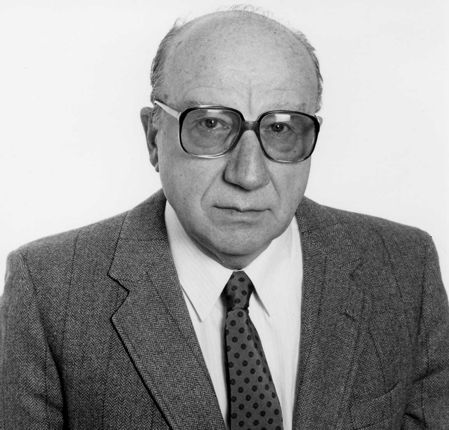Jan Tauc
DOI: 10.1063/PT.3.1177
Jan Tauc, a pioneer in semiconductor physics, died peacefully on 28 December 2010 in Washougal, Washington; he had heart failure after a period of declining health following the death of his wife, Vera.
Jan was born in Czechoslovakia in Pardubice, Bohemia (now in the Czech Republic), in 1922. In 1932 his father, a post-office accountant, was transferred to Opava in the Sudetenland. When Adolf Hitler annexed that region six years later, Jan and his family, not being ethnic Germans, were given only a few hours to leave. After the expulsion, his father was eventually transferred to a job in Brno, Moravia, and Jan received a three-year fellowship to continue high school in Nimes, France. The following year the Germans occupied the Czech regions, including Moravia, and Jan was forced to return to Brno. He finished his high school degree there, but the Nazis had closed the universities.
After World War II started, Jan was allowed to attend a two-year professional school while working at a weapons factory. In his free time he
taught himself physics and mathematics. As the war ended, universities reopened with an overwhelming number of students but a shortage of professors, many of whom had died in the war or in concentration camps. Jan got his electrical engineering degree in two years and in 1949 obtained a doctor of technical sciences degree, both from the Czech Technical University in Prague.
Having heard of the discovery of the transistor, Jan began research on semiconductors and built the first point-contact transistor in Czechoslovakia. In 1952 the Communist government founded the Czechoslovak Academy of Sciences (ČSAV) for the purpose of centralizing scientific research. Although not a party member, Jan was asked to head the semiconductor department of the ČSAV’s Institute of Technical Physics; he held that position, and a decade later also one as professor at Charles University, until 1969. His department at ČSAV soon achieved recognition on both sides of the Iron Curtain, and Jan was allowed to attend the fourth International Conference on the Physics of Semiconductors in Rochester, New York. There he convinced the organizing committee to choose Prague as the venue for its next conference. The fifth conference thus took place in Prague in 1960, with Jan as chair of the program committee. It was the first such event in the Communist world.
Jan was interested in photovoltaic, thermoelectric, and optical properties of crystalline semiconductors. He collaborated with Emil Antončík and Antonín Abrahám to unravel the role of the spin–orbit splitting in the dielectric function. In the mid 1960s Jan became interested in amorphous semiconductors because of their ease of preparation and their photovoltaic applications. His 1966 paper on the electronic and optical properties of amorphous germanium, written with Romanian colleagues Radu Grigorovici and Ana Vancu, became the basis of semiempirical studies of amorphous structures and led to the often-used eponymy “Tauc gap.” Research on amorphous semiconductors and metals occupied much of his subsequent scientific life.
In the spring of 1969, about seven months after the Russians had invaded Czechoslovakia, Jan was still able to leave the country and spend a few months with Florin Abeles at the University of Paris. In June Jan finally arrived, with his family, at Bell Labs in Murray Hill, New Jersey, for a 12-month stay. The idea to emigrate had not crossed his mind until October, when he received a letter from the ČSAV revoking his leave and demanding his immediate return under threat of prosecution. One of us (Cardona) and his wife, close friends of the Taucs, went to Murray Hill to help them sort out the agonizing situation. The Cardonas mentioned the possibility of a faculty position at Brown University in Providence, Rhode Island. When it materialized the following year, Jan accepted the position as professor of engineering and physics, which he held for 22 years until his retirement in 1992. In Prague, meanwhile, he was sentenced in absentia to five years in jail, so he could not risk returning to Czechoslovakia in late 1970 to attend the funeral of his parents, who died in a tragic accident in their apartment.
Jan’s scientific life can be divided into two periods of about 20 years each: Prague and Providence. It is remarkable that he produced such influential papers under the precarious economic and political conditions during the first period. His most cited paper, with Grigorovici and Vancu, belongs to that time; it was that work that secured him the position at Brown. In December 1987 he and his Brown coworkers Humphrey Maris and Christian Thomsen were issued a patent for a method to investigate properties of thin films using picosecond spectroscopy. He wrote or edited several books and was an editor of three professional journals.
Jan received numerous honors, including the 1982 Frank Isakson Prize and the 1988 David Adler Lectureship Award of the American Physical Society and the De Scientia et Humanitate Optime Meritis medal from the Academy of Sciences of the Czech Republic.
Jan’s legacy lies not only in his science but also in the generation of scientists lucky enough to have been mentored by him. His many friends remember his wry humor and warmth. They would turn to him often for his guidance and wisdom but more importantly for his friendship.

Jan Tauc

More about the Authors
Manuel Cardona. Max Planck Institute for Solid State Research Stuttgart, Germany.
Sidney Nagel. University of Chicago Chicago, Illinois.
Richard Zallen. Virginia Tech Blacksburg.
Karel Závěta. Charles University Prague, Czech Republic.
